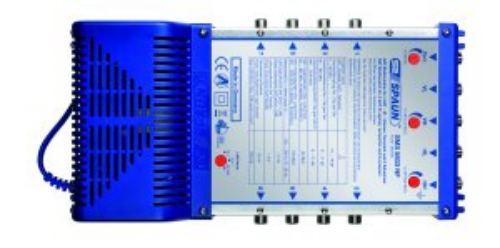I was talking to one of our Signal Pros the other day and we were discussing multiswitches. A multiswitch is a funny little combination of traffic cop and splitter, much akin to a router but for satellite TV.
The myth part comes when you talk about providing power to the multiswitch. A lot of our marine customers swear by the old Spaun and Eagle Aspen multiswitches, and they balk when I tell them that not all multiswitches need a power supply. So, it seems to me that it’s time for a bit of an explainer.
Generation 1 multiswitches
It’s important to understand the difference between the two generations of multiswitches commonly used in the US. The first generation are much more similar to the multiswitches used in Europe, while the second generation are much more specific to the needs of today’s users.
The first generation multiswitch does one thing. It interprets DiSeqC commands sent by a receiver. These commands tell the multiswitch which source signal to send down to which output. That’s really it. It’s a neat trick but the term “one-trick pony” does certainly apply. This sort of multiswitch is used throughout the world for satellite television. Older DISH setups can use nearly any generic multiswitch, while older DIRECTV setups still need something specific like the WB68. It’s not that the WB68 is any more complex, it’s just that DIRECTV’s implementation of the DiSeqC protocol is a little different from the norm.
The generation 1 multiswitches do not need to be powered. It’s not some sort of magic. Older DIRECTV and DISH receivers can supply up to 24 volts through the coax cable. This is done to power the satellite dish, but the needs of the multiswitch are so small that it can use some of this power as well.
Powered multiswitches exist because not every satellite receiver all over the world supplies power. But, all the ones from DIRECTV, DISH, and Bell do.
Generation 2 multiswitches
Current-generation multiswitches like DIRECTV’s SWM30 and DISH’s DPH42 do a lot more than older multiswitches. Their goal is to supply multiple receivers and DVRs over a single line. In other parts of the world where multi-tuner DVRs are less common, this isn’t much of a consideration. However, without a multiswitch, something like DISH’s Hopper 3 would require 16 lines in and up to 8 lines out. You can see where that would be a no go for most people.
So, these next-level multiswitches change the signal so that it can be carried over a single wire. Without getting into too much detail, DIRECTV’s system splits the available bandwidth on a cable into 14 parts and allows 13 different signals to be broadcast down a single wire. (The 14th part is for communication up the line.) DISH’s system takes all the potential signals coming from each of its three satellite locations and stacks them up on a single wire. A receiver or DVR uses a special tuner to pick only what you need, similar to what an over-the-air television would do.
Doing more stuff means needing more power, and that’s why multiswitches like this do always need power.
Myth busted?
If you’re still using what we would call a “legacy” satellite system, with receivers like DIRECTV’s H24 or DISH’s 722, you’ll want to look at your options. Increasingly, these older systems are beginning to need repair and parts are harder to get. There are options for converting your old system to a newer one, whether you’re at home, in the office, on the road, or in the water. But, you have to ask the right people. Call DIRECTV or DISH and they won’t have the answers. You need the experts.
Call the folks at Signal Connect instead. We have over 20 years of experience with this kind of upgrade. When you call 888-233-7563, you’ll get an expert in our Detroit-area office, not a script reader in an overseas call centers. We’ll work to understand your needs and recommend the best possible solution. Call during East Coast business hours, or if it’s after hours just fill out the form below.

